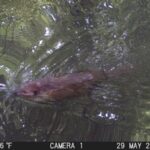Though sometimes thought of as a polluted and dead river, the Bronx River is absolutely teeming with aquatic life. Decades of hard work have helped make the river a home to dozens of species of fish, crustaceans, amphibians, reptiles, mammals, and aquatic invertebrates. Sadly, this abundance of life was made painfully obvious on the morning of August 31st when hundreds of fish began to die in the north Bronx, eventually piling up in the New York Botanical Garden (NYBG).
Following a summer of very little rainfall and extremely low water levels along the length of the river, on August 31st the river’s level suddenly rose. Bronx River Alliance staff noted that the river had an unusually powerful, musty stench that could be smelled from a distance. At the NYBG, staff noticed that the river had become very cloudy, and a thick, white foam was forming on the river’s surface. Then, they began to notice dead and dying fish drifting downstream. The dying fish were in distress, gasping at the water’s surface, moving into shallow areas, and in some cases crawling out onto dry land as if escaping from something in the water. Hundreds of fish, including sunfish, catfish, dace, darters, suckers, and carp were soon piling up dead along the banks of the river from 233rd Street down to the NYBG.
The sudden mass death of fish or other aquatic life is known as a fish kill. Fish kills are an indication that conditions in the water have changed rapidly in a way that is harmful for wildlife. Fearing that a dangerous chemical had been spilled into the water, the Bronx River Alliance canceled public events that would have potentially put community members in contact with the river. So, what actually happened?

We still don’t know. The United States Geological Survey (USGS) is a scientific agency of the United States government, and they own and manage a device called a streamgage that continuously measures different characteristics of the Bronx River. During this fish kill, the streamgage in the NYBG showed that the river’s height increased dramatically, indicating that water started to gush downstream from the north. At the same time, the dissolved oxygen, salinity, and pH levels in the water decreased, suggesting that the river was being diluted by an unknown source of water that made the river hazardous for life.
The river appears to have returned to its normal state now. However, we are deeply saddened and frustrated by this massive loss of wildlife. It will take some time for these populations to rebound to their previous numbers, and in the meantime the Bronx River’s ecosystem will see a ripple effect as other animals, who depended on the fish and the roles they played, experience their loss. We will continue to reach out to our partners and other state and local agencies for help with investigating this incident.
What can you do to help? Please report dead wildlife or unusual smells or signs of a chemical spill to 311. You can also show support for a healthy Bronx River by joining the Bronx River Eco Team which meets 4 times a year, and/or getting involved in one of our water quality monitoring programs as a Community Science Steward. If you see an outfall pipe spilling liquid into the river during dry weather, you can report it here. You can always help us identify problems on the river by continuing to report these observations to us directly by emailing christian.murphy@bronxriver.org. Learn more by reading The Bronx Ink’s article on the fish kill here.






